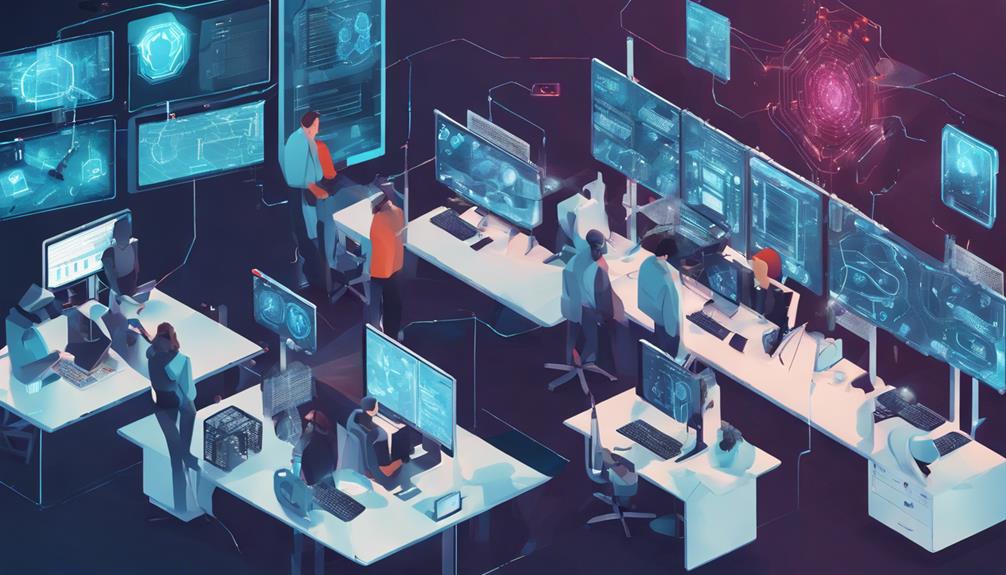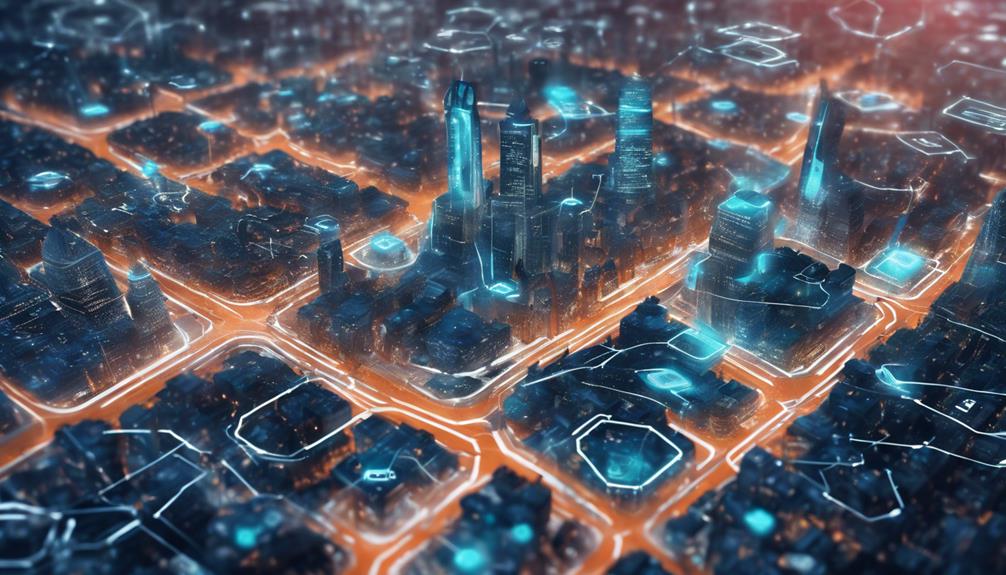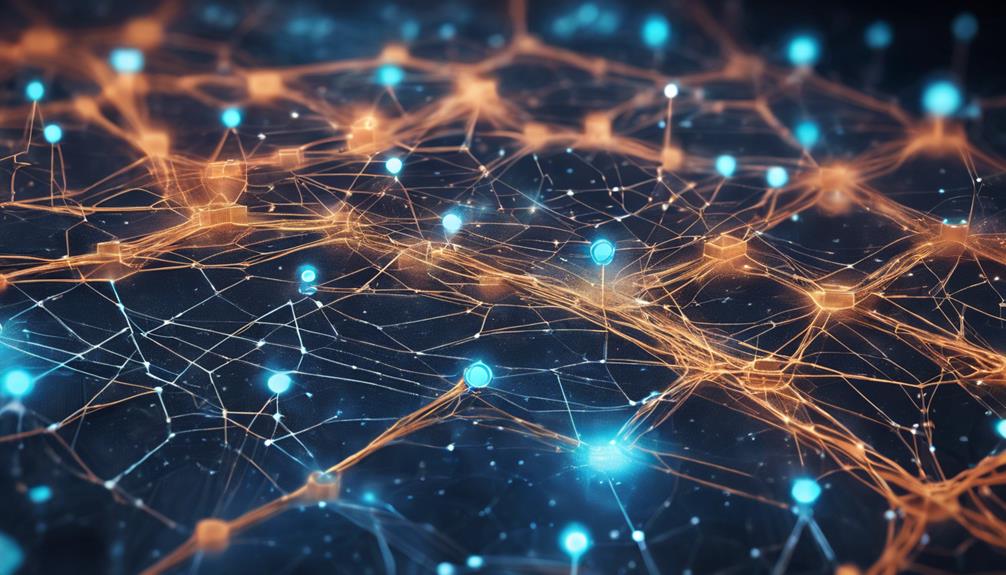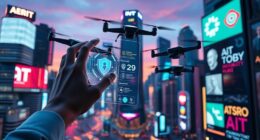Discover the forefront of AI cybersecurity at the upcoming conference. Explore innovative strategies like AI-driven behavioral analytics and real-time threat detection. Gain insights on defending against emerging threats such as fileless malware and AI-powered threats. Learn how AI can revolutionize your security posture, enhancing incident response and proactive risk mitigation. Engage with industry experts, witness hands-on demonstrations, and investigate real-world case studies showcasing AI's impact. Don't miss this opportunity to fortify your defenses and stay ahead of cyber threats. Join us to access the latest insights and strategies for a more secure digital future.
Key Takeaways
- Explore cutting-edge AI-driven threat detection systems.
- Learn innovative defense strategies for safeguarding organizations.
- Gain insights into advanced AI cybersecurity solutions.
- Discover real-world case studies of AI impact on security practices.
- Enhance security posture with AI for effective cyber threat defense.
Event Overview
The AI Cybersecurity Conference is a premier virtual summit designed to provide cybersecurity professionals with cutting-edge solutions in the rapidly evolving AI cybersecurity landscape. This full-day event offers educational sessions, keynote speakers, and panel discussions tailored for professionals seeking innovative strategies to protect data in the AI era.
By focusing on managing organizations in the AI cybersecurity landscape and empowering decision-makers, attendees can gain valuable insights into the latest trends and best practices in the field.
For an admission fee of $75, participants gain access to an interactive platform where they can engage with industry experts, network with peers, and earn 8 CPE credits for professional development.
This conference presents a unique opportunity to stay ahead of the curve in AI cybersecurity, equipping professionals with the knowledge and tools needed to navigate the complex challenges of today's digital landscape.
Cutting-Edge Strategies

Exploring advanced techniques in applying AI to enhance cybersecurity defenses is a key focus of the AI Cybersecurity Conference. Attendees can expect to investigate cutting-edge strategies aimed at bolstering security measures through the power of artificial intelligence.
Here are some key highlights to look forward to:
- Uncover the potential of AI-driven behavioral analytics in identifying and mitigating cyber threats.
- Learn about leveraging AI to protect sensitive data and fortify defense mechanisms against evolving cyber risks.
- Discover innovative approaches to managing organizational cybersecurity in the era of rapid technological advancements.
- Gain insights into detecting anomalies effectively using AI-powered tools and staying informed on the latest trends in AI cybersecurity.
Industry Innovations

At the forefront of the AI Cybersecurity Conference agenda lies a focus on Industry Innovations, highlighting the latest advancements and practical applications shaping the cybersecurity landscape. Industry leaders and experts will explore the transformative power of artificial intelligence (AI) in cybersecurity, showcasing how AI is revolutionizing defense strategies and safeguarding valuable data. By attending this conference, participants will have the opportunity to gain insights from keynote speakers who are pioneers in the field, offering valuable perspectives on the integration of AI technologies into cybersecurity frameworks.
| Industry Innovations in AI Cybersecurity |
|---|
| 1. AI-driven threat detection systems |
| 2. Machine learning for anomaly detection |
| 3. Predictive analytics for risk assessment |
These sessions will equip attendees with the knowledge and tools needed to stay ahead of the curve and implement best practices for leveraging AI in cybersecurity effectively. Don't miss out on the chance to explore the cutting-edge solutions that are reshaping the industry's approach to cybersecurity.
Emerging Threats Discussion
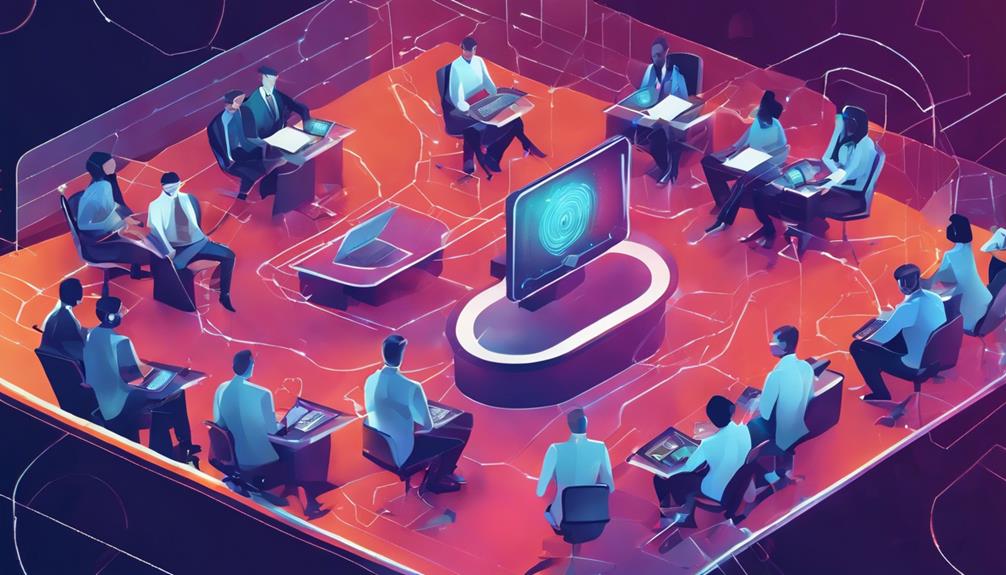
At the AI Cybersecurity Conference, we are delving into the critical discussion of emerging threats in the cybersecurity landscape. From new attack techniques to the vulnerabilities present in AI systems, the need for robust defense strategies is more pressing than ever.
Join us as we explore the evolving nature of cyber threats and the essential strategies required to effectively combat them.
New Attack Techniques
The cybersecurity landscape is constantly evolving with cybercriminals utilizing novel attack techniques to breach security defenses. As technology advances, so do the methods used by malicious actors to infiltrate systems and compromise sensitive information.
Here are some key points to keep in mind regarding new attack techniques in the threat landscape:
- Sophisticated Phishing Schemes: Cybercriminals are becoming increasingly adept at crafting convincing phishing emails that trick users into giving up their credentials or downloading malware.
- Fileless Malware Attacks: This type of malware operates in the computer's memory without leaving a trace on the system's hard drive, making it harder to detect by traditional security measures.
- AI-Powered Threats: Hackers are leveraging artificial intelligence to create more targeted and effective attacks, making it challenging for conventional cybersecurity tools to keep up.
- Supply Chain Vulnerabilities: Cybercriminals are exploiting weaknesses in the supply chain to infiltrate networks, posing a significant risk to organizations that rely on third-party vendors for services.
Staying informed about these emerging threats is essential for developing robust cybersecurity strategies that can effectively mitigate risks and protect valuable assets.
Vulnerable AI Systems
Vulnerable AI systems present a critical concern within the evolving landscape of cybersecurity threats. As AI technologies, particularly those based on Machine Learning, become increasingly integrated into various sectors, they also become attractive targets for malicious actors. Chief Information Security Officers are now tasked with safeguarding these systems against potential vulnerabilities that could be exploited by cyber threats.
Emerging threats exploit weaknesses in AI algorithms and systems, manipulating them to produce biased or malicious outcomes. To mitigate these risks, security measures must be implemented to protect against exploitation of AI vulnerabilities. Understanding and addressing these vulnerabilities is essential for ensuring the integrity and security of AI systems.
Organizations must prioritize continuous monitoring, regular updates, and robust testing protocols to identify and address potential weaknesses promptly. By staying vigilant and proactive in managing AI system vulnerabilities, Chief Information Security Officers can effectively protect their organizations from emerging cyber threats.
Defense Strategies Needed
As the focus shifts towards emerging threats in cybersecurity, the imperative for implementing robust defense strategies becomes increasingly evident. Security leaders are recognizing the evolving landscape of cyber threats and the critical need for proactive defense measures.
To navigate this dynamic environment effectively, organizations must leverage the latest threat intelligence to stay ahead of potential risks. By understanding and utilizing advanced AI technologies, security teams can identify and mitigate emerging threats more efficiently.
The conference will provide valuable insights on how AI plays a pivotal role in detecting, responding to, and preventing cyber threats in real-time.
- Explore innovative defense strategies to safeguard your organization.
- Gain a deeper understanding of the importance of threat intelligence in enhancing security posture.
- Learn how AI technologies can revolutionize the way we approach cybersecurity.
- Network with industry experts to stay informed about the latest advancements in defense mechanisms.
AI-Powered Solutions
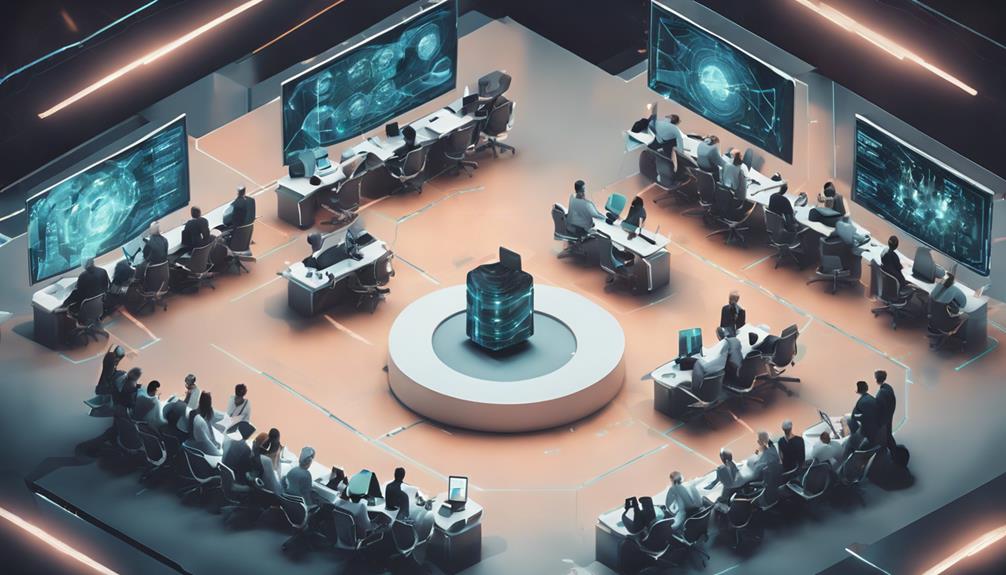
AI-powered solutions in cybersecurity are revolutionizing the way organizations detect and respond to threats. By leveraging machine learning and predictive analytics, these tools offer enhanced threat detection and faster response times.
Implementing AI technology can empower organizations to stay ahead of cyber threats, strengthen defenses, and proactively mitigate risks.
Enhanced Threat Detection
Enhancing threat detection capabilities through the utilization of AI-powered solutions involves deploying advanced algorithms and machine learning techniques. Leveraging AI in cybersecurity offers a proactive approach to identifying and mitigating potential security risks.
Here are some key aspects to take into account:
- Real-time analysis: AI solutions can analyze vast amounts of data in real-time, enabling swift identification and response to security threats.
- Improved incident response: Organizations can enhance their incident response times by utilizing AI, leading to more efficient threat mitigation.
- Reduced false positives: AI-powered systems help in decreasing false alarms, allowing security teams to focus on genuine threats.
- Continuous learning: Machine learning models in AI cybersecurity continuously adapt to new threats, providing ongoing defense mechanisms against evolving cyber risks.
Faster Response Times
Employing AI in cybersecurity operations greatly speeds up response times to security incidents through the application of machine learning algorithms for real-time threat analysis and detection. By leveraging AI-powered solutions, organizations can enhance their incident response capabilities, enabling them to swiftly identify and mitigate potential threats.
These advanced tools automate threat detection, allowing for the rapid prioritization of alerts and the efficient allocation of resources for incident investigation. Through AI-driven incident response mechanisms, security teams can streamline their processes, reducing the time taken to address security breaches.
Moreover, AI facilitates proactive threat hunting by continuously analyzing vast amounts of data to identify patterns indicative of malicious activity. This proactive approach to cybersecurity not only accelerates response times but also strengthens overall security posture by enabling organizations to stay ahead of evolving threats.
Incorporating AI into incident response strategies is essential for modern cybersecurity practices, ensuring swift and effective defense mechanisms against cyber threats.
Latest Advancements Showcase

The 'Latest Advancements Showcase' at the AI Cybersecurity Conference highlights cutting-edge developments in AI technology for cybersecurity professionals. This segment provides a glimpse into the innovative solutions shaping the future of cybersecurity.
Here are four intriguing features of the showcase:
- Advanced Threat Intelligence Integration: Explore how AI is revolutionizing threat intelligence gathering and analysis, enhancing proactive defense mechanisms.
- Next-Generation Technology Solutions: Discover the latest tools and technologies leveraging AI to detect, prevent, and respond to cyber threats effectively.
- Interactive Demonstrations: Engage with live demonstrations showcasing AI-powered cybersecurity solutions in action, offering a hands-on experience.
- Expert Insights and Q&A Sessions: Gain valuable knowledge from industry leaders on implementing AI in cybersecurity strategies, with opportunities for interactive discussions.
Immerse yourself in the forefront of AI-driven cybersecurity advancements at the conference, where these elements combine to provide a thorough understanding of the evolving landscape of digital defense.
Real-World Case Studies

Real-world case studies showcased at the AI cybersecurity conference offer valuable insights into the practical applications and impact of AI in enhancing security measures.
These case studies explore how organizations have effectively utilized AI to bolster their cybersecurity defenses, providing attendees with concrete examples of successful projects.
Practical Security Applications
Within the domain of cybersecurity, tangible examples showcasing the practical applications of AI are becoming increasingly prevalent. Organizations worldwide are leveraging AI technologies to enhance their security strategies.
Here are some real-world case studies highlighting the practical applications of AI in cybersecurity:
- Essential Threat Detection: AI is being used to detect and respond to cyber threats in real-time, greatly improving security operations.
- Enhanced Incident Response: Through AI-powered automation and analysis, organizations can respond to security incidents swiftly and accurately.
- Improved Security Posture: AI plays an important role in bolstering overall security posture by identifying vulnerabilities and mitigating risks proactively.
- Benefits of Integration: Understanding the tangible benefits of integrating AI into security strategies through hands-on examples can help organizations optimize their cybersecurity defenses.
These examples underscore the transformative impact of AI on security practices, emphasizing the importance of embracing innovative technologies to stay ahead of evolving cyber threats.
Impact of AI
Leveraging AI technologies in cybersecurity has demonstrably revolutionized threat detection and incident response capabilities in numerous real-world case studies. Organizations incorporating AI-driven solutions have witnessed enhanced threat detection, faster response times, and reduced false positives. The adaptability of AI in countering evolving cyber threats has been a game-changer, leading to improved risk management and stronger defense mechanisms.
| Case Study | Impact of AI in Cybersecurity | Key Benefits |
|---|---|---|
| Company A | Enhanced threat detection and incident response efficiency | Reduced false positives |
| Organization B | Faster response times and improved risk management | Stronger defense mechanisms |
| Business C | Adaptability to counter evolving cyber threats effectively | Enhanced incident response efficiency |
These real-world examples underscore the tangible benefits of integrating AI into cybersecurity strategies, showcasing how AI can notably bolster security postures and mitigate risks effectively.
Enhancing Cybersecurity Posture

Enhancing the cybersecurity posture of organizations is a critical endeavor in today's increasingly complex threat landscape. To fortify your defenses effectively, consider the following key strategies:
- Implementing advanced cyber threat intelligence solutions to proactively identify and mitigate potential risks.
- Conducting regular security assessments and audits to identify vulnerabilities and areas for improvement.
- Establishing robust incident response plans to swiftly address and contain cyber threats when they occur.
- Providing continuous training and education for employees to enhance their awareness of cybersecurity best practices.
Protecting Against Cyber Threats

Implementing AI technologies is vital for organizations aiming to bolster their defenses against evolving cyber threats. By leveraging AI for predictive threat detection and anomaly detection in cybersecurity, businesses can stay ahead of malicious actors.
Additionally, collaborative data initiatives and threat intelligence sharing play an important role in collective defense against cyber threats. Organizations must prioritize Supply Chain Security to safeguard against vulnerabilities in the interconnected digital ecosystem.
The Cybersecurity Summit offers a platform to learn advanced defense strategies using AI and participate in tabletop exercises led by experts like the US Secret Service. Attendees will gain valuable insights and tools to navigate cybersecurity challenges effectively through AI integration.
Don't miss this opportunity to enhance your cybersecurity posture and protect your organization against the ever-changing landscape of cyber threats. Stay informed, stay prepared, and stay secure with the power of AI.
Staying Ahead in Security

Organizations must continually adapt and evolve their security strategies to effectively stay ahead in the ever-changing landscape of cybersecurity.
To enhance your security posture and combat cyber threats effectively, consider the following:
- Utilize Threat Intelligence: Stay informed about the latest cyber threats and vulnerabilities to proactively defend your systems.
- Embrace AI Integration: Implement innovative AI solutions to strengthen your defenses and detect potential security breaches.
- Engage with Industry Experts: Attend conferences, webinars, and workshops to gain insights from cybersecurity professionals and stay updated on industry trends.
- Collaborate with Vice President: Foster collaboration between IT teams and executives, including the Vice President, to foster alignment of security priorities with business objectives.
Frequently Asked Questions
Is Cybersecurity Going to Be Replaced by Ai?
Cybersecurity is not going to be replaced by AI. Instead, AI enhances threat detection and response capabilities, augmenting human expertise for more effective defenses. The combination of AI and human intelligence is essential for creating robust cybersecurity strategies and defenses.
How Effective Is AI in Cybersecurity?
AI in cybersecurity is highly effective, detecting threats rapidly, reducing response times substantially, and analyzing data for anomalies in real-time. Machine learning models can self-improve, enhancing threat intelligence and automating security tasks efficiently.
What Is AI Security?
AI security refers to the utilization of artificial intelligence technologies to bolster cybersecurity defenses. By leveraging AI algorithms, organizations can detect, analyze, and respond to cyber threats in real-time, enhancing overall protection against malicious activities and data breaches.
How Does Generative AI Affect Cybersecurity?
Generative AI poses significant challenges in cybersecurity by enabling the creation of convincing fake data for malicious purposes. This technology, capable of mimicking human behavior, can fuel sophisticated attacks like phishing and social engineering, emphasizing the need for heightened security measures.
Conclusion
Interested in staying ahead in the ever-evolving world of cybersecurity? Don't miss the AI cybersecurity conference, where you can gain valuable insights into cutting-edge strategies, industry innovations, and AI-powered solutions.
Learn from real-world case studies and discuss emerging threats to enhance your cybersecurity posture. Join us to protect against cyber threats and equip yourself with the knowledge and tools needed to navigate the digital landscape safely.
Don't wait, secure your spot today!



